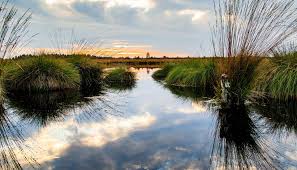
Wetlands, islands and tropical and subtropical humid forests are key areas. Wetlands are even more important than forests per hectare, both for climate change mitigation and biodiversity conservation. Wetlands store an enormous amount of carbon dioxide and are a haven for biodiversity- restoring these is an urgent priority.
India is one of the most high priority areas globally- it has the Western Ghats which are vital for biodiversity. For carbon sequestration, there are the upper Gangetic plains, a very rich forest biomass that can be restored.
Why Wetlands Matter?
- Wetland is the most crucial ecological biome…. these marshy ecosystems, covered with hydrophyte plants, provide the world’s fresh water, reduce flood severity, stop soil erosion and house 40% of the world’s species.
- Wetlands include thePantanal of Brazil, Bolivia and Paraguay, the Congolian Swamp Forests, Louisiana’s Bayous, Florida’s Everglades and the Sudarbans in India and Bangladesh.
- 35% of the world’s wetlands have been lost between 1970 to 2015, converted towards agriculture, housing projects, etc. Major cities have been built on drained wetlands, including Washington D.C., constructed on a converted wetland along the Potomac and Anacostia rivers.
- However, there are inspiring wetland restoration and rewilding cases- Uruguay set up a protected reserve in the Banados del Este wetland, restoring the degraded ecosystem and rewilding biodiversity.
- San Fransisco Bay restored its tidal marsh, once, 2,00,000 acres, with only 40,000 left by 1999- Cargill Inc., which held tracts for salt, sold back its holdings. Over 8,000 acres of ponds, hayfields and eelgrass have been restored.
- 60% wetlands in Botswana’s Okavango Delta were saved by regulated fishing- rewilding successfully drew ecotourism.
For biodiversity, restoration is complex- it depends on how degraded an ecosystem is. In the tropics, biodiversity recovery could take five decades. Carbon is faster- in 20 years, over half the carbon targets outlined can be met in tropical areas, while in 66 years, 90% carbon targets can be achieved.
Economic growth and the restoration of nature go hand in hand. Restoration gives clean water, stops soil erosion and helps pollination- these increase growth and reduce public spending on diseases, etc. There are synergies between the health of nature and economic development.
Matter referenced:
1. National geographic, UNDP, UNFCCC, New York Times, Science Direct.
2. Bernardo Strassburg (Economist & Env. Scientist), Executive Director, International Institute for Sustainability, Rio de Janerio, Brazil. “Rewilding and restoring 15% global land will prevent 60% extinctions, sequester 30% CO2”. Article published in Times Nation, Times of India, Ahmedabad, 24 Oct. 2020.
By: Dr. Bhawana Asnani.
Happy to see Reviews, Additions, Suggestions and Comments, further.

Leave a Reply
You must be logged in to post a comment.